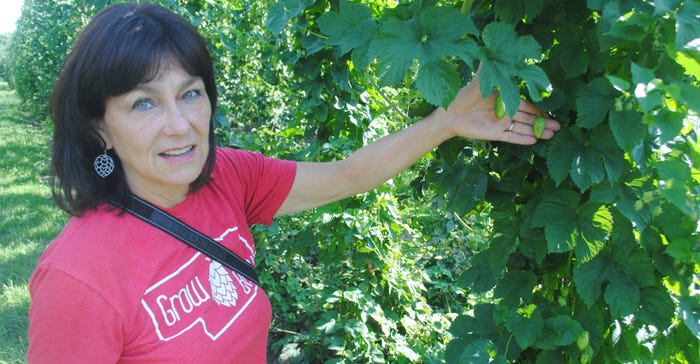
ALL ABOUT THE CONE: Annette Wiles inspects the hop cones at Nebraska Hop Yards, a hop farm she established with husband Bruce in 2015 near Plattsmouth, Neb. This season is their fourth harvest on 32 acres of hops. They hope to one day grow to 150 acres.
Harvesttime is harvesttime, no matter what the crop is. If you are harvesting corn or soybeans, you are concerned about moisture content and maturity, along with any weeds and diseases that nagged your crop throughout the growing season. If you are growing commercial hops, it isn’t all that different.
Nebraska Farmer stopped by Nebraska Hop Yards near Plattsmouth to visit with Annette Wiles about the hop farm she and husband Bruce own and operate. It was early August and nearly harvesttime when we visited, so Annette was anxiously awaiting her alpha and beta analysis numbers to see if harvest could commence in the coming days.
A sample of at least 60 cones per cultivar or variety are tested for alpha acids like humulone, cohumulone and adhumulone, which are used for bittering in the brewing process. The tests check beta acids like lupulone, colupulone and adlupulone, which give beer longevity and antimicrobial qualities. The test also indicates a Hop Storage Index and essential oils, which provide flavor and aroma to the beer.
If the numbers aren’t right, harvest must be delayed, because brewers need the right quality of hops to use in the brewing process, Annette said.
Hops are harvested as the color of the lupulin changes from a bright yellow to a deep golden color, and the desired alpha and beta numbers are reached. After testing, hops are dried and conditioned to a moisture level less than 12%.
There are roughly 50 acres in Nebraska in hops production, as of 2018. Most hops in the U.S. are grown in Washington, Oregon and Idaho. But thanks to an explosion in the craft beer industry, hop acres are growing, not only in Nebraska, but in other nontraditional hops production states.
“The commercial hop industry is very new to Nebraska — less than 10 years,” says Katie Kreuser, Nebraska Extension Hop Program coordinator. “When people traveled West, they did carry rhizomes and cones with them that fell off trains and established themselves, or they established them on farms across the state.”
There are wild cultivars being tested by the University of Nebraska and elsewhere, because of their adaptability to the region’s climate and pests.
“In UNL research, we are learning how different cultivars perform agronomically — what pests affect them, how our climate affects them and if their acid levels meet the recommended levels,” Kreuser said.
Bruce and Annette are helping UNL with research, comparing more native cultivars with high-producing industry favorites. The analysis doesn’t just include yield, Annette said. It also looks at disease and insect resistance.
“Downy mildew is hands down the biggest challenge,” Kreuser said. “Fusarium canker has been an issue, along with some insect pests such as Japanese beetles and potato leaf hoppers. The damage this season from Japanese beetles is extremely regionalized,” she says. “They cause problems by defoliating the plants, and in large numbers can quickly move down a plant. In some cases, they have munched on the cones.”
In 2015, the Wileses planted 22 hop varieties on 3 acres of land that was once a golf course near Plattsmouth. The original buildout included 288 poles for their trellis system that supported 2,145 plants. This harvest season is their fourth.
“No one had grown hops in Nebraska on a commercial scale,” Annette said. “We did our research and attended conferences to learn about hops. Now, we have grown to 32 acres, and we’d like to get to 150 acres.”
But the manual labor required to plant, care for and harvest hops is substantial, she said.
They plant varieties of hops developed in Washington and Oregon, like Yakima Gold, Tahoma and Nugget. They also plant other varieties that have European origins like Perle, Saaz and Tettnanger. Each hop has a distinct strength that it brings to the final product. But Annette said they do not all yield the same, or deal with weather and pests the same. This has been a learning process.
Beyond the growing of hops, Annette and Bruce added a taproom in 2017 called The Hop Yard, featuring Nebraska craft beers for guests and events that are made using their own hops. Because of the agritourism aspect of their business, they planted pumpkins, so they could feature more kids’ activities during their annual Octoberfest celebration.
The agronomic part of hops production has required thinking outside the box. Because moisture is such a big factor in hops quality, the Wileses developed their own drying system. Bruce used an old silage blower to develop a machine that would remove plant material during the harvest process. Innovations like that have made the business work.
The Wileses’ Midwest Hop Yard Supplies business is developing a hop dryer for use by small hop yards. That enterprise also provides consulting services, and supplies and materials needed for the establishment and maintenance of a hopyard trellis system.
Annette knows that the research they are doing at Nebraska Hop Yards and their outreach to help other small hopyards in the state is breaking new ground and helping a new agriculture industry develop in the region. A big part of that effort is learning which varieties are best suited to Nebraska soils and climate.
Learn more about hops production in Nebraska by contacting Kreuser at [email protected]. Learn about Nebraska Hop Yards at midwesthopproducers.com.
About the Author(s)
You May Also Like






